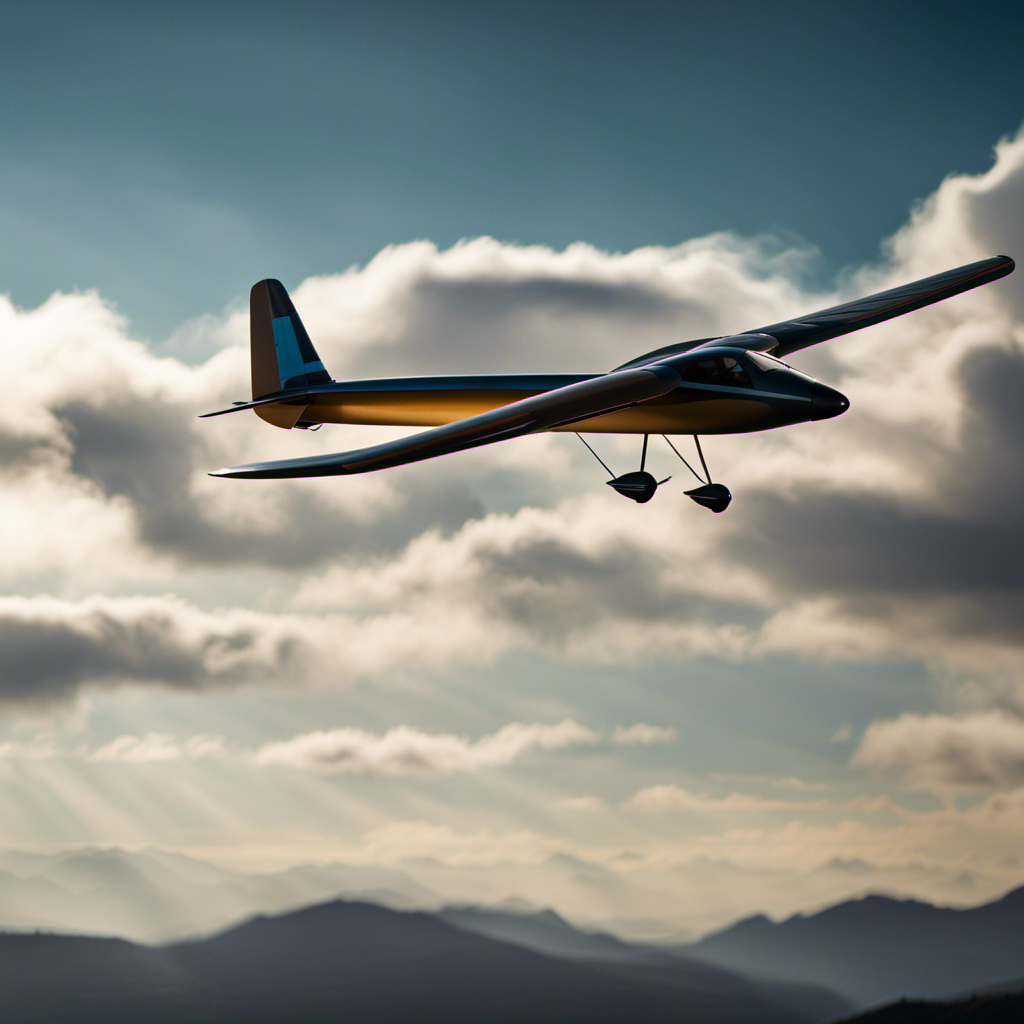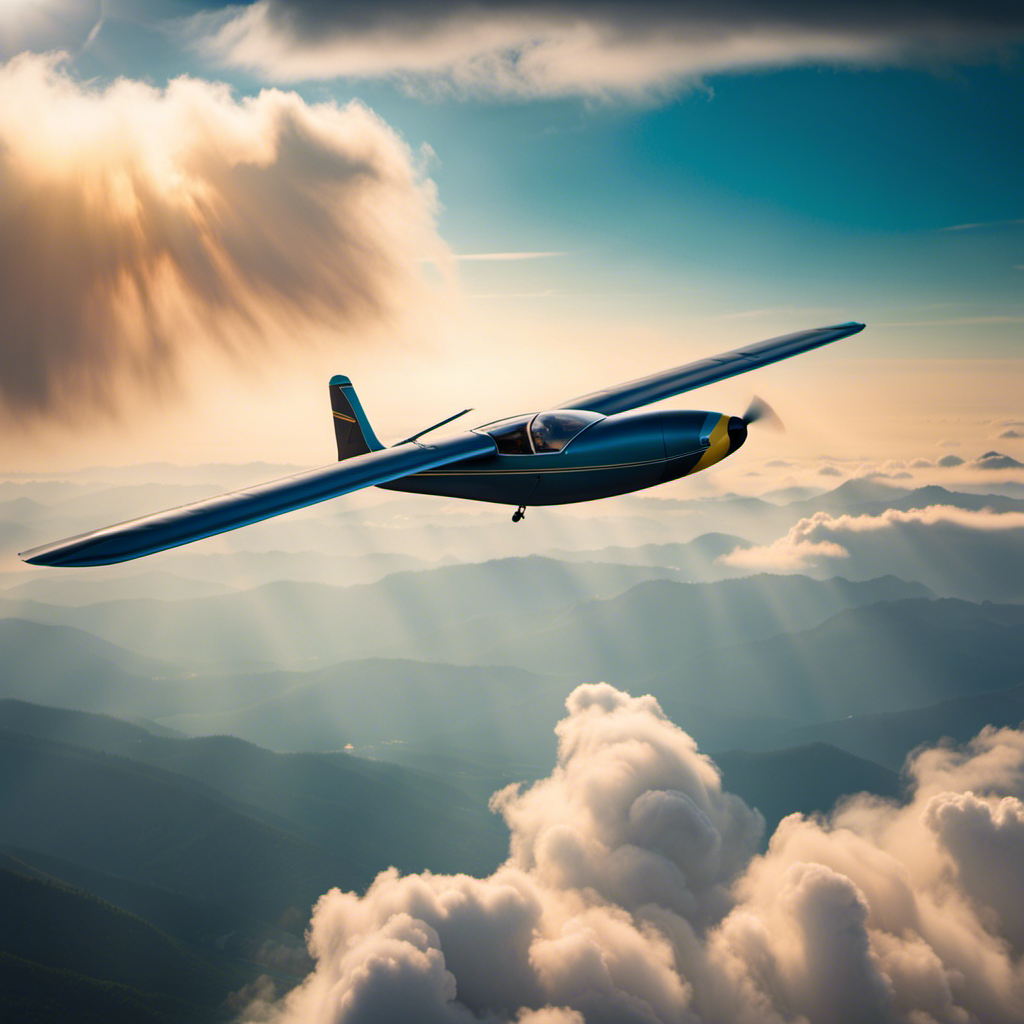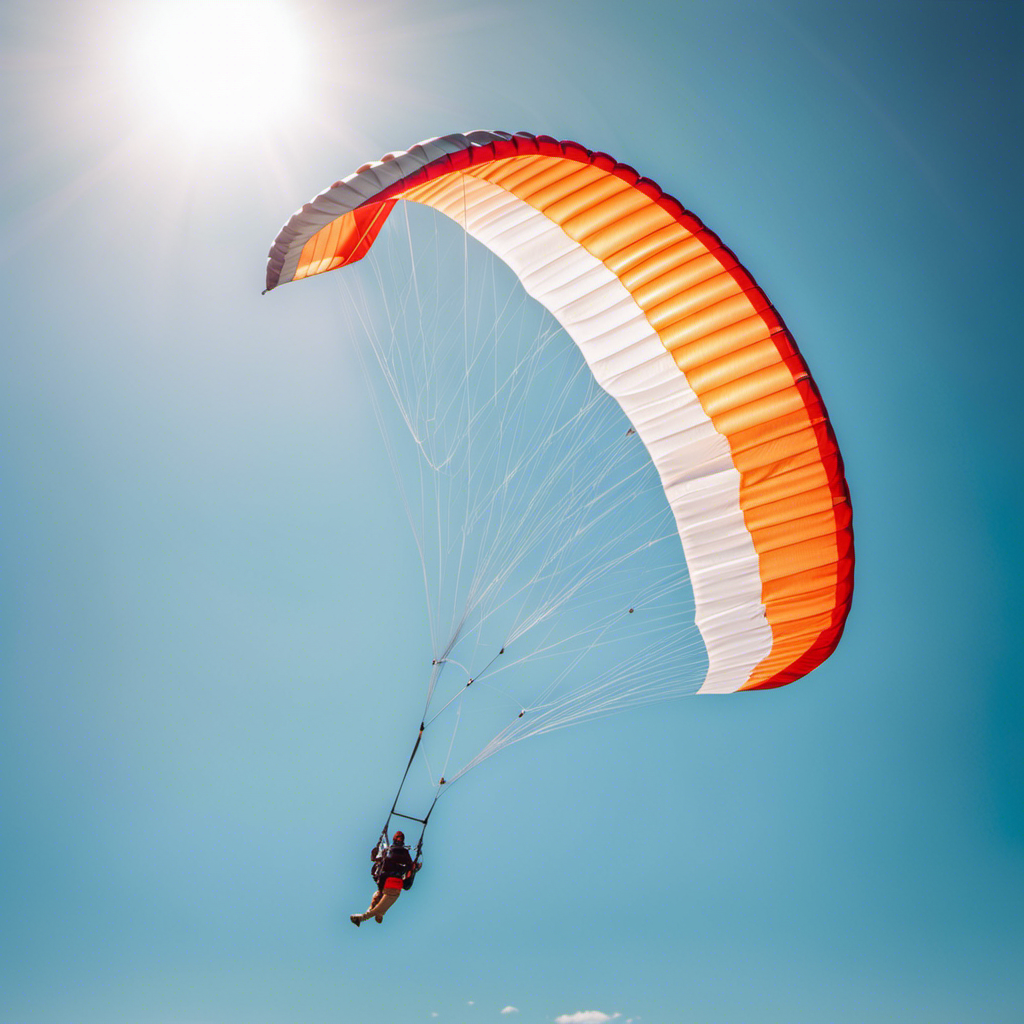Similar to how a bird effortlessly soars through the sky, a glider relies on aerodynamic principles to stay aloft.
In this article, I will delve into the intricate world of glider flight, exploring the basics of aerodynamics, the design and construction of gliders, various launching methods, and the art of soaring techniques.
Join me on this journey as we uncover the secrets behind what keeps a glider in the air.
Key Takeaways
- Gliders rely on aerodynamics, specifically lift, to stay in the air.
- Wing shape, profile, and area optimize lift generation in gliders.
- Factors like angle of attack and wing loading affect the amount of lift generated.
- Glider performance is influenced by the design of the wings, fuselage, control surfaces, and materials used.
The Basics of Aerodynamics
The basics of aerodynamics explain how a glider stays in the air. Aerodynamic principles play a crucial role in the lift generation that keeps a glider airborne. Lift is the force that counteracts the weight of the glider, allowing it to stay aloft.
The primary principle behind lift generation is Bernoulli’s principle, which states that as the speed of a fluid increases, its pressure decreases. In the case of a glider, as it moves through the air, the shape of its wings, known as airfoils, creates a difference in air pressure above and below the wings. The air moving over the curved upper surface of the wing has to travel a longer distance, resulting in lower pressure, while the air moving beneath the wing experiences higher pressure. This pressure difference generates lift, which supports the glider in the air.
Understanding the basics of aerodynamics is essential for glider design and construction. By utilizing the principles of lift generation, glider designers can create wings with specific shapes and profiles that optimize lift. Additionally, factors such as the angle of attack, wing span, and wing area also influence the amount of lift generated. By carefully considering these design elements, glider manufacturers can create aircraft that maximize efficiency and performance.
Now that we have explored the fundamentals of aerodynamics, let’s delve into the intricate world of glider design and construction.
Glider Design and Construction
When it comes to glider design and construction, there are several key points to consider.
First, the wings and wing loading play a crucial role in the performance of the glider. The shape and size of the wings, as well as the distribution of weight, affect the lift and stability of the aircraft.
Second, the fuselage and control surfaces contribute to the maneuverability and control of the glider. The design of the fuselage, along with the placement and operation of control surfaces like the ailerons and elevators, determine how the glider responds to pilot input.
Wings and Wing Loading
One key factor in keeping a glider in the air is the weight of the wings and how that affects the wing loading. The wing design and lift generation are crucial for maintaining flight. Here are three important aspects to consider:
-
Wing shape: The shape of the wing plays a vital role in generating lift. A glider’s wings are typically long and slender, with a high aspect ratio to minimize drag and maximize lift.
-
Wing area: The size of the wings determines the amount of lift that can be generated. Gliders have large wings to provide sufficient surface area for generating lift and supporting the weight of the aircraft.
-
Wing loading: Wing loading refers to the weight supported by each square foot of wing area. It is important to maintain an optimal wing loading to ensure the glider can stay aloft. A higher wing loading increases the glider’s sinking speed but allows for faster flight.
Considering the weight of the wings and their impact on wing loading, let’s now explore the role of the fuselage and control surfaces in glider flight.
Fuselage and Control Surfaces
To maintain flight, it’s important to consider the role of the fuselage and control surfaces in a glider.
The fuselage design plays a crucial role in providing structural support and housing vital components such as the cockpit, wings, and tail. It must be streamlined to reduce drag and enhance aerodynamic efficiency.
Control surfaces, on the other hand, are responsible for maneuvering the glider during flight. These surfaces include the ailerons, elevators, and rudder, which allow for roll, pitch, and yaw control respectively. The effectiveness of these control surfaces greatly influences the glider’s handling and stability. By manipulating them, pilots can adjust the glider’s attitude and direction.
In order to further explore the intricacies of glider flight, let’s delve into the impact of materials and weight on its performance.
Materials and Weight
Consider the materials used and the weight of your glider as they directly influence its performance in flight. The choice of materials affects the strength, stiffness, and overall durability of the glider. Lighter materials, such as carbon fiber composites, are preferred as they reduce the weight of the glider, allowing for better maneuverability and increased glide ratio.
Additionally, the weight distribution of the glider must be carefully balanced to ensure stable flight dynamics. A well-balanced glider will have its center of gravity located in the correct position, which helps maintain stability and control during flight. The weight of the glider also affects its ability to climb and maintain altitude.
By minimizing weight and using suitable materials, we can optimize the performance of our glider in the air.
Now, let’s explore the various launching methods for gliders.
Launching Methods
When it comes to launching a glider, there are three main methods: tow launch, winch launch, and aerotow.
In a tow launch, the glider is connected to a tow plane with a rope and is pulled into the air.
A winch launch involves using a ground-based winch to rapidly unwind a cable, propelling the glider forward.
An aerotow is when a powered aircraft tows the glider into the air using a towline.
Each method has its own advantages and considerations, and understanding the intricacies of these launch methods is crucial for a successful glider flight.
Tow Launch
Keep in mind that during a tow launch, you’ll need to maintain a steady climb and communicate effectively with the tow pilot.
Hang gliding is a thrilling sport that relies on various launch methods to get airborne. One common method is the tow launch, where the glider is attached to a powered aircraft by a towline. As the aircraft gains speed and lifts off, the towline tightens, pulling the glider along. Once sufficient altitude is reached, the glider releases from the towline and continues its flight independently. This method allows for longer and higher flights compared to parachute launching.
Now, let’s move on to the next launch method, the winch launch, which offers its own unique set of challenges and advantages.
Winch Launch
To experience the thrill of a winch launch, you’ll need to hold on tight as the cable rapidly pulls you into the sky. As the winch begins to wind up the cable, the glider is released from the towline and starts its ascent.
During a winch launch, several aerodynamic forces come into play:
-
Lift: As the glider gains speed, the wings generate lift, counteracting the force of gravity and allowing the glider to climb.
-
Drag: The glider experiences drag as it moves through the air, caused by the friction between the glider’s surface and the surrounding air molecules.
-
Thrust: The winch provides the initial thrust to propel the glider forward and upward.
-
Weight: The glider’s weight, including the pilot and any additional equipment, is constantly acting downwards.
These forces work together to propel the glider into the air, allowing it to soar and glide effortlessly.
Now, let’s transition to the next section about ‘aerotow,’ where a different method is used to launch gliders.
Aerotow
After discussing the winch launch technique, it is now time to delve into the next method of getting a glider airborne: aerotow.
Unlike the winch launch, where a ground-based winch is used to rapidly pull the glider into the air, aerotow involves the glider being towed into the sky by a powered aircraft. This technique requires precise coordination between the glider pilot and the towplane pilot to ensure a safe and efficient departure.
Aerotow techniques involve maintaining a steady position behind the towplane, adjusting the glider’s pitch to maintain the correct position, and releasing the towline at the appropriate altitude. Safety is of utmost importance during aerotow operations, as any mishap could have severe consequences. Proper communication, adherence to standard procedures, and strict attention to the towplane’s movements are crucial for maintaining aerotow safety.
Now, let’s transition into the subsequent section about soaring techniques.
Soaring Techniques
When it comes to soaring techniques, glider pilots employ three key methods: ridge soaring, thermal soaring, and wave soaring.
Ridge soaring involves flying along the edge of a ridge or mountain. This technique utilizes the updraft created by the wind hitting the slope to gain altitude.
Thermal soaring, on the other hand, relies on rising columns of warm air. Glider pilots use these columns to lift the glider higher.
Lastly, wave soaring is a technique used in areas with strong winds and mountainous terrain. In this technique, the interaction between the wind and the mountains creates standing waves. Gliders can ride these waves to reach incredible altitudes.
Ridge Soaring
You can maximize your glider’s lift by ridge soaring along the slopes of mountains. Ridge soaring is a technique that takes advantage of the wind that is forced upwards by the slope of a mountain or hill. As the wind encounters the slope, it is deflected upwards, creating an upward flow of air.
This upward flow, known as ridge lift, can be used by gliders to maintain altitude or even gain altitude without the need for an engine. The key to successful ridge soaring is finding the right weather conditions. Strong and steady winds that are perpendicular to the ridge are ideal. Additionally, the shape and orientation of the ridge can also affect the quality of the lift.
Transitioning into the subsequent section about thermal soaring, another technique used by glider pilots, involves harnessing the power of rising columns of warm air.
Thermal Soaring
To maximize lift during thermal soaring, pilots take advantage of rising columns of warm air. Thermals are pockets of warm air that rise from the surface due to heating from the sun. As a glider pilot, understanding thermals and their impact on lift is crucial for optimizing glider performance.
When a glider enters a thermal, it gains altitude as it circles within the column of rising warm air. The glider’s wings generate lift as they encounter the upward-moving air, allowing the glider to climb higher. Pilots must carefully navigate and exploit thermals to maintain altitude and extend their flights. By skillfully utilizing thermals, glider pilots can stay airborne for extended periods and cover long distances.
Transitioning to the next topic, wave soaring, requires a different approach to harnessing the power of the atmosphere.
Wave Soaring
Wave soaring is a technique used by pilots to harness the energy of mountain waves for extended and efficient glider flights. Unlike thermal soaring, which relies on rising columns of warm air, wave soaring takes advantage of wave conditions created by winds interacting with mountains.
These waves can generate powerful updrafts, allowing gliders to climb to great heights and cover long distances. The key to successful wave soaring lies in identifying the lift sources and understanding the wave patterns. Pilots must analyze the wind direction, speed, and stability to determine where the best lift can be found.
By carefully studying the wave conditions, pilots can optimize their flight path and maximize their time in the air.
Now, let’s explore the instruments and equipment that aid pilots in navigating these soaring opportunities.
Instruments and Equipment
When it comes to flying a glider, having the right instruments and equipment is crucial for a safe and successful flight.
Three key instruments that are essential for any glider pilot are the variometer, airspeed indicator, and altitude indicator.
The variometer is used to measure the rate of climb or descent, providing valuable information on the vertical speed of the glider.
The airspeed indicator, on the other hand, measures the speed of the glider through the air, allowing the pilot to maintain the optimal speed for efficient flight.
Lastly, the altitude indicator displays the current altitude of the glider, helping the pilot navigate and maintain the desired flight level.
Variometer
The variometer measures the rate of climb or descent of a glider. It is a crucial instrument that provides valuable information about glider performance. The accuracy of the variometer is paramount, as it allows pilots to make precise adjustments to maintain optimal glider performance.
By accurately measuring the rate of climb or descent, pilots can determine the effectiveness of their flight techniques and make necessary adjustments to maximize efficiency. The variometer relies on changes in atmospheric pressure to calculate the rate of climb or descent. It uses a pressure sensor to measure these changes and translates them into visual or auditory indicators for the pilot.
With the variometer providing accurate information, pilots can effectively control the glider’s altitude and optimize its performance.
Speaking of altitude control, another important instrument is the airspeed indicator…
Airspeed Indicator
After learning about the variometer, let’s dive into another essential instrument in a glider’s cockpit: the airspeed indicator. This instrument plays a crucial role in determining the glider’s performance and safety during flight.
The airspeed indicator measures the speed of the glider through the surrounding air. It consists of a dynamic pressure sensor, which senses the difference between the static air pressure and the pressure caused by the glider’s motion. The sensor then converts this pressure difference into an airspeed reading.
Understanding airspeed is vital because it directly affects the glider’s lift and drag forces. With accurate airspeed measurement, pilots can optimize their glider’s performance by adjusting their flight techniques accordingly.
In summary, the airspeed indicator provides real-time information about the glider’s speed through the air, allowing pilots to make precise adjustments for optimal glider performance.
Now, let’s explore the next instrument in our journey: the altitude indicator.
Altitude Indicator
Now let’s delve into another important instrument in a glider’s cockpit: the altitude indicator.
This instrument plays a critical role in providing pilots with accurate altitude measurements during flight. By using various sensors and instruments, the altitude indicator is able to determine the glider’s height above sea level.
This information is crucial for understanding the glider’s position in the sky and maintaining proper flight dynamics. The altitude indicator is typically calibrated to display altitude in feet or meters, allowing pilots to make precise adjustments to their flight path.
Understanding and monitoring altitude is essential for safe glider operation, as it helps pilots maintain proper clearances from other aircraft and avoid obstacles. With the altitude indicator as a vital tool in the cockpit, pilots can ensure a smooth and controlled flight, mitigating risks and ensuring a safe journey.
Safety Precautions
Before taking off, it’s important for glider pilots to ensure that all safety precautions have been followed. When it comes to emergency procedures, being prepared is crucial. Glider pilots must have a thorough understanding of the aircraft’s emergency systems and procedures, such as the deployment of emergency parachutes or the proper use of emergency communication devices.
Additionally, pilots must stay up-to-date with the latest weather conditions. Weather can greatly impact the safety of a glider flight, so it is essential to closely monitor factors such as wind speed, temperature, and cloud cover. By staying informed about weather conditions, pilots can make informed decisions about when to fly and when to ground their glider to avoid potential hazards.
Transitioning into the next section about training and certification, it is clear that safety is a top priority in glider aviation. Proper training and certification ensure that pilots have the necessary knowledge and skills to operate a glider safely. From learning about aerodynamics and flight mechanics to practicing emergency procedures and understanding weather patterns, the training process equips pilots with the tools they need to make informed decisions and handle any situation that may arise during a flight.
Training and Certification
Transitioning into the next section about training and certification, it’s evident that safety remains a top priority in the world of glider aviation. To ensure that pilots are well-prepared and competent in flying gliders, rigorous training methods and a thorough certification process are in place.
The training methods for glider pilots typically involve a combination of theoretical knowledge and practical flight experience. Pilots are required to undergo ground school training, where they learn about aerodynamics, weather patterns, navigation, and emergency procedures. This theoretical knowledge forms the foundation of their understanding of glider aviation.
In addition to the classroom training, pilots must also gain hands-on experience through flight training. This involves flying under the guidance of experienced instructors who teach them the necessary skills and techniques to safely operate a glider. They learn how to perform pre-flight inspections, take-off and landing procedures, as well as maneuvering and controlling the glider during flight.
Once the training is complete, pilots must go through a certification process to obtain their glider pilot license. This process usually includes a written exam to test their theoretical knowledge and a practical flight test to assess their flying skills. The certification process ensures that pilots meet the required standards and are capable of safely operating gliders.
With the completion of training and certification, pilots are well-equipped to participate in the exhilarating world of glider racing. The next section will explore the excitement and challenges of this thrilling sport.
Glider Racing
Are you ready to experience the excitement and challenges of glider racing? Glider racing is a thrilling sport that combines the skill of piloting with the strategy of competition.
To be successful in glider racing, proper glider maintenance is crucial. Ensuring that the glider is in top condition allows for optimal performance during races. Regular inspections, repairs, and adjustments are necessary to keep the glider in peak condition.
In addition to maintenance, competition strategies play a crucial role in glider racing. Pilots must carefully analyze weather conditions, wind patterns, and the race course to develop a winning strategy. Understanding how to maximize lift and minimize drag is essential for gaining an advantage over competitors. Finding the optimal balance between speed and efficiency is a key aspect of glider racing strategy.
As glider racing is a highly technical sport, pilots often rely on advanced instrumentation and technology to gather and analyze data during races. This data helps pilots make informed decisions and adjust their strategies in real-time. By utilizing all available resources and employing effective competition strategies, glider pilots can increase their chances of success in racing.
Transitioning into the subsequent section about ‘glider clubs and communities,’ it is important to note that glider racing is not just an individual endeavor. Glider clubs and communities provide a supportive environment for pilots to learn, share knowledge, and participate in races together.
Glider Clubs and Communities
After learning about the exhilarating world of glider racing, let’s now delve into the vibrant glider clubs and communities that fuel this thrilling sport. These clubs serve as the backbone of gliding, providing a platform for pilots to connect, share knowledge, and participate in glider competitions.
Here are three key aspects of glider clubs and communities:
-
Community Support: Glider clubs foster a sense of camaraderie among pilots, creating a supportive environment where members can learn from each other’s experiences and share tips and tricks. This sense of community encourages pilots to push their boundaries and improve their skills.
-
Training and Education: Glider clubs often offer training programs for aspiring pilots, providing them with the necessary knowledge and skills to safely operate gliders. These programs cover topics such as aerodynamics, meteorology, and flight techniques, ensuring that pilots are well-prepared for glider competitions.
-
Maintenance Facilities: Glider clubs typically have well-equipped maintenance facilities where pilots can perform routine inspections and repairs on their gliders. These facilities are essential for keeping gliders in optimal condition, ensuring their safety and performance during flights.
Transition: Now that we have explored the world of glider clubs and communities, let’s move on to the next section and uncover the sheer joy and exhilaration that gliding brings.
The Joy of Gliding
When you’re soaring through the sky in a glider, the feeling of weightlessness is truly extraordinary. The thrill of soaring effortlessly, with only the wind as your guide, is a sensation like no other. Gliding allows you to experience the freedom of flight in its purest form, without the noise or vibration of an engine.
The absence of an engine also means that you can enjoy the serenity of the skies, uninterrupted by the roar of propellers or jet engines.
For those who seek a competitive edge, glider competitions provide an opportunity to showcase their skills and push the boundaries of gliding. These competitions test a pilot’s ability to navigate through challenging conditions, such as thermal updrafts and crosswinds. Pilots must demonstrate precise control and decision-making to maximize their glider’s performance and achieve the highest scores.
In the world of gliding, the joy comes not just from the act of flying itself, but also from the pursuit of excellence and the thrill of competition. Glider pilots constantly strive to improve their skills, seeking out new challenges and pushing the limits of what is possible.
Whether it’s the tranquility of a solo flight or the adrenaline of a glider competition, the joy of gliding is an experience that truly takes you to new heights.
Frequently Asked Questions
How much does a glider weigh?
The weight of a glider depends on its structure. Gliders are designed to be lightweight, typically weighing between 300 to 600 pounds. This allows for better lift and maneuverability during flight.
How long can a glider stay in the air?
The endurance of a glider, or how long it can stay in the air, is influenced by several factors. These include thermals, ridge lift, wave lift, pilot skill, weight and balance, and weather conditions.
Do gliders have engines?
No, gliders do not have engines. They rely on glider propulsion, which includes techniques like thermals, ridge lift, and wave lift to stay in the air. Engineless flight offers benefits such as reduced noise and lower operating costs.
How fast can gliders fly?
Gliders can reach impressive speeds, depending on various factors such as wind conditions and glider design. By harnessing the principles of glider aerodynamics, gliders can achieve speeds of up to 150 km/h or more.
Can gliders fly at night?
Night flying challenges for gliders include reduced visibility, reliance on artificial light sources, and increased risk of encountering turbulence. However, there are also benefits to gliding at night, such as cooler air temperatures and calmer winds.
Conclusion
In conclusion, the exhilarating world of gliding is a testament to the marvels of aerodynamics. With carefully designed gliders and skillful launching methods, gliders effortlessly take to the skies, defying gravity’s grip.
Soaring techniques and a vast array of instruments and equipment further enhance the experience, allowing gliders to navigate the skies with precision. Training and certification ensure that glider pilots are well-prepared and capable of handling the complexities of gliding.
Glider racing and the vibrant glider clubs and communities add a sense of camaraderie and shared passion to this captivating aviation sport. Embarking on a gliding adventure is truly a soaring delight.
With a heart that soars as high as the skies, Aria, affectionately known as “Skylark,” is the driving force behind Soaring Skyways. Her journey into the gliding world began as a young dreamer gazing up at the soaring birds, yearning to experience the weightlessness and freedom they embodied. With years of experience both in the cockpit and behind the scenes, Aria’s commitment to the gliding community is unwavering.










